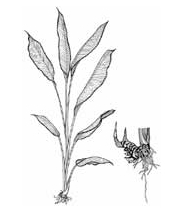Gabriele Stoll
Natural Crop Protection in the Tropics
Letting Information Come to Life
Methods of Field Protection
Insects
Insect-controlling plants
Turmeric
Curcuma domestica
Fam. Zingiberaceae
General
Turmeric is a perennial plant with a short
stem and tufted leaves. It originated in India and Southeast
Asia, where it grows in deciduous monsoon forests. Today it is
grown on a large scale in India, China and the East Indies, and
has reached worldwide distribution. It thrives up to 2,000
metres in places with a rainfall of 1,000–2,000 mm. It
grows well on loams and alluvial soils, but does not tolerate
water logged soil conditions. It is often grown as a
successional crop to rice or sugar cane, but also in mixed
cultivation with vegetables. It is an important spice and has
considerable commercial importance as one of the principal
ingredients of curry. Turmeric responds well to organic manures
and yields 13,000–33,500 kg/ha of rhizomes.
Plant parts with insect-controlling
properties
Rhizome
Mode of action
Repellent, insecticidal, antifungal.
Target pests
Field insects
Aphids
Armyworms
Beet armyworm
Caterpillars
Cotton semilooper
Diamondback moth
Green leafhopper
Mites
Rice stem borer
Rice leafroller
general
general
Spodoptera litura
general
Anomis flava
Plutella xylostella
Nephotettix virescens
general
Scirpophaga incertulus
Cnaphalocrocis medinalis
Field diseases
Powdery mildew
Oidiopsis taurica
Erysiphe spp.
Storage insects
Cowpea weevil
Grain weevil
Lesser grain borer
Adzuki bean weevil
Rice flour beetle
Rice weevil
Callosobruchus maculatus
Sitophilus granarius
Rhizopertha dominica
Callosobruchus chinensis
Tribolium spp.
Sitophilus oryzae
Methods of preparation and use
Turmeric has excellent pest repellent
properties. In combination with cow urine it controls several
diseases and pests. PERIES proposes dipping a thread in
turmeric liquid and stretching it over paddyfields to produce
the repellent effect against unspecified rice pests
Sprays
1 kg of turmeric rhizomes are shredded and
3–4 litres of cow urine are added and mixed well. The
mixture is diluted with 15–20 litres of water. Emulsifier
is added at the rate of 4 ml/litre to the solution.
In Thailand, 500 g of turmeric rhizomes
are chopped and soaked overnight in 2 litres of water. The next
day the extract is filtered and filled up to 20 litres. Sprayed
to control vegetable pests such as diamondback moth and beet
armyworm.
Attracting predatory birds
This yellow rice attracts birds which then
feed on pest larvae in the paddy, e.g. armyworms, rice
stemborers.
1 kg of rice and 125 g of turmeric powder
are required to treat one hectare of paddyfield. The rice is
cooked and excess water is filtered. Then it is mixed with
turmeric powder. Small lumps of yellow coloured rice are put in
small vessels and placed in the main field in 8 to 10 places.
At the same time, some poles are stuck into the field as
resting sites for the birds.
This procedure is started once larvae are
observed and repeated until the crop reaches the flowering
stage. The turmeric rice should be renewed every 2–3
days.
Other uses of plant or substance
Turmeric is highly appreciated in
traditional medicine, as condiment in food preparation, natural
dye and for religious rituals.
